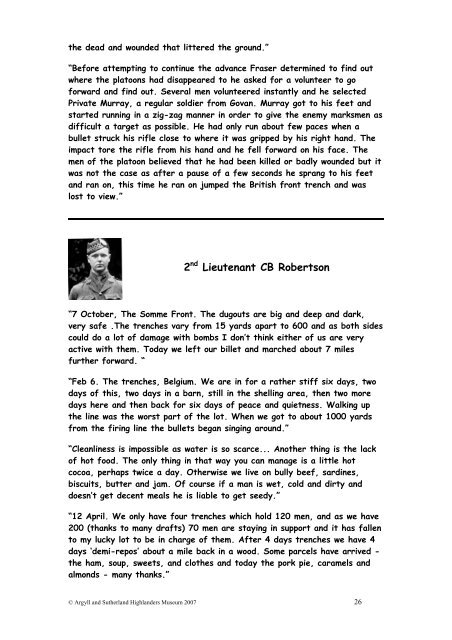The First World War - Historic Scotland
The First World War - Historic Scotland
The First World War - Historic Scotland
Create successful ePaper yourself
Turn your PDF publications into a flip-book with our unique Google optimized e-Paper software.
the dead and wounded that littered the ground.”<br />
“Before attempting to continue the advance Fraser determined to find out<br />
where the platoons had disappeared to he asked for a volunteer to go<br />
forward and find out. Several men volunteered instantly and he selected<br />
Private Murray, a regular soldier from Govan. Murray got to his feet and<br />
started running in a zig-zag manner in order to give the enemy marksmen as<br />
difficult a target as possible. He had only run about few paces when a<br />
bullet struck his rifle close to where it was gripped by his right hand. <strong>The</strong><br />
impact tore the rifle from his hand and he fell forward on his face. <strong>The</strong><br />
men of the platoon believed that he had been killed or badly wounded but it<br />
was not the case as after a pause of a few seconds he sprang to his feet<br />
and ran on, this time he ran on jumped the British front trench and was<br />
lost to view.”<br />
2 nd Lieutenant CB Robertson<br />
“7 October, <strong>The</strong> Somme Front. <strong>The</strong> dugouts are big and deep and dark,<br />
very safe .<strong>The</strong> trenches vary from 15 yards apart to 600 and as both sides<br />
could do a lot of damage with bombs I don’t think either of us are very<br />
active with them. Today we left our billet and marched about 7 miles<br />
further forward. “<br />
“Feb 6. <strong>The</strong> trenches, Belgium. We are in for a rather stiff six days, two<br />
days of this, two days in a barn, still in the shelling area, then two more<br />
days here and then back for six days of peace and quietness. Walking up<br />
the line was the worst part of the lot. When we got to about 1000 yards<br />
from the firing line the bullets began singing around.”<br />
“Cleanliness is impossible as water is so scarce... Another thing is the lack<br />
of hot food. <strong>The</strong> only thing in that way you can manage is a little hot<br />
cocoa, perhaps twice a day. Otherwise we live on bully beef, sardines,<br />
biscuits, butter and jam. Of course if a man is wet, cold and dirty and<br />
doesn’t get decent meals he is liable to get seedy.”<br />
“12 April. We only have four trenches which hold 120 men, and as we have<br />
200 (thanks to many drafts) 70 men are staying in support and it has fallen<br />
to my lucky lot to be in charge of them. After 4 days trenches we have 4<br />
days ‘demi-repos’ about a mile back in a wood. Some parcels have arrived -<br />
the ham, soup, sweets, and clothes and today the pork pie, caramels and<br />
almonds - many thanks.”<br />
© Argyll and Sutherland Highlanders Museum 2007 26













![Elgin Cathedral Wedding Brochure [pdf, 544kb] - Historic Scotland](https://img.yumpu.com/22301571/1/190x151/elgin-cathedral-wedding-brochure-pdf-544kb-historic-scotland.jpg?quality=85)



